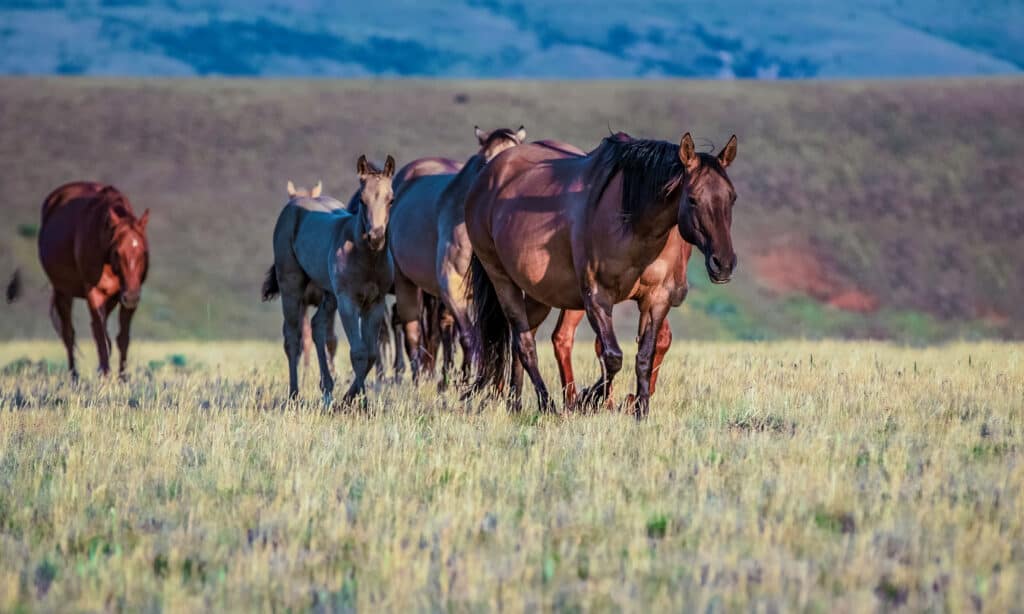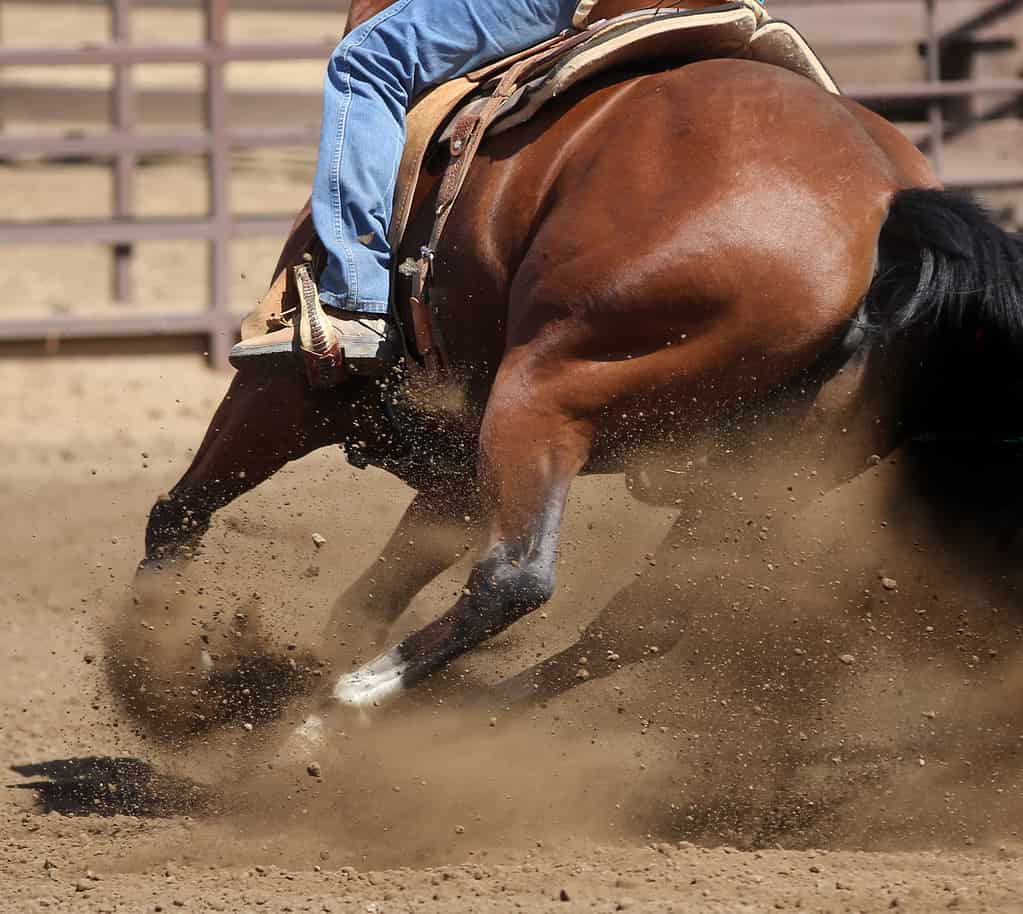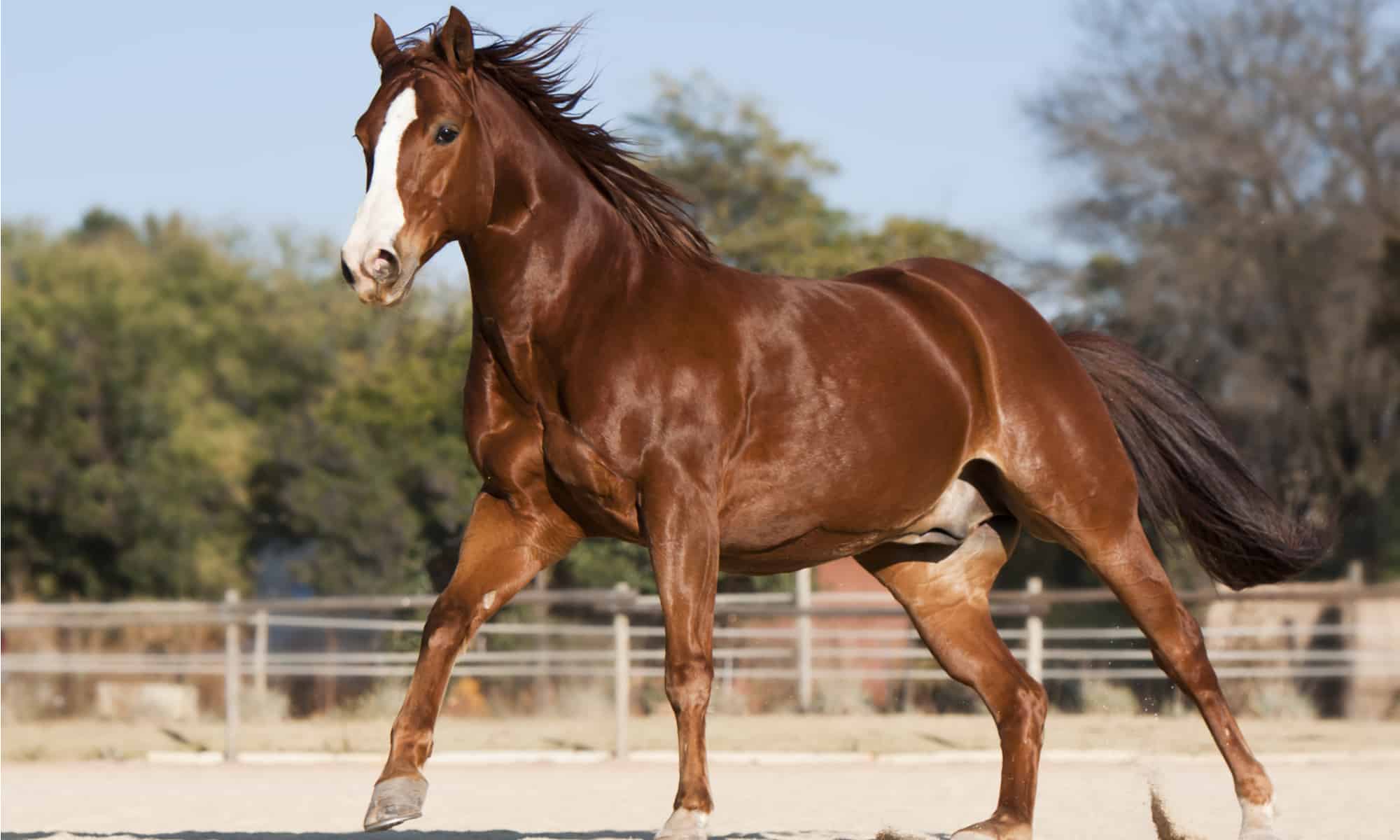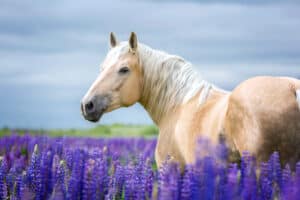The American Quarter Horse is one of the most beloved horse breeds in the United States. They’re known for their exceptional speed, agility, and versatility. In this complete guide, we’ll look at this breed’s rich history, unique characteristics, and multifaceted roles of this horse breed.
History and Origin

Colonial America was the beginning of the American Quarter Horse’s origin.
©Jaco Wiid/Shutterstock.com
The American Quarter Horse began in colonial America when European settlers brought horses to the New World. These horses were largely of Spanish descent, and they laid the foundation for the Quarter Horse that we know today. Spanish horses had tons of endurance and agility, which they passed onto the Quarter Horse.
As colonists and settlers continued to move across the United States, they brought reliable, versatile horses with them to assist them in their tasks. Over time, this led to the Spanish horse being crossed with others and creating the Quarter Horse.
Simply put, the selective breeding of horses in America eventually led to the creation of the new breed.
As American colonies developed and the frontier expanded, the need for a versatile, strong horse was even more obvious. Early American horse breeders selectively bred for the characteristics that the frontiersmen need.
Eventually, this led to an extremely fast horse. This led to a distinctive type of horse that was described as the “American Quarter Running Horse.” This breed could cover a quarter-mile faster than any other breed, which is how it got its name. Eventually, this was shortened to “American Quarter Horse,” which is often shortened further to just Quarter Horse.
In the late 19th century, this breed finally began to gain recognition. The American Quarter Horse Association was founded in 1940 as one of the earliest registries. It sought to preserve the breed’s pedigree and maintain its unique traits. This organization set the first breed standards that have led to the Quarter Horse that we know today.
These standards have changed over the years. However, they still guide breeding today.
Characteristics and Breed Standard

This horse breed is one of the most common in America and was bred largely to keep up with the demands of the west.
©Christy berry/Shutterstock.com
The American Quarter Horse is known for a few distinctive physical characteristics. You don’t have to be well-trained to recognize these horses, as they have been fairly carefully bred over generations to have certain traits.
Body Conformation
Quarter horses are very compact and muscular. They usually stand between 14 to 16 hands tall and weigh between 1,000 to 1,200 pounds. Their bodies are well-balanced and obviously built for work. They have a strong hindquarters and a deep chest. Their conformation makes them a great choice for anything that requires quick, powerful movements.
Coat Colors and Patterns
While quarter horses come in many different coat colors, certain ones are more prevalent than others. The most common colors are bay, sorrel, black, and brown. Many of these horses also have white facial markings and leg markings.
You’ll also find other coat patterns like roan, dun, and buckskin.
Breed Standards and Associations
The American Quarter Horse Association has played a central role in setting and maintaining the breed standards for this breed. These standards help define what a Quarter horse is, which is very important given the number of breeders spread across the world.
These standards include things like body proportions and bone structure. They’re judged at equine competitions to evaluate which horse is the best example of these standards. The ideal Quarter horse is typically one that is well-muscled with strong, sloping shoulders and well-balanced legs.
While not a physical trait, this breed also has a particular temperament explained in these standards. They’re supposed to be gentle and amiable, which makes them a solid choice for riders of all ages. They should be very willing to work and cooperate with humans.
Comparison with Other Horse Breeds
It’s easy to confuse the American Quarter Horse with other breeds. They’re also better for certain things than other horses. However, while they are versatile, they aren’t the best option for all jobs.
- Thoroughbred vs. Quarter Horse: Thoroughbreds are noted for their speed and stamina, making them the preferable horse for racing. The Quarter Horse is fast, but they excel most in shorter sprint distances.
- Arabian vs. Quarter Horse: Arabian horses are often noticed for their refined appearance. The Quarter horse is much more robust and muscular.
- Clydesdale vs. Quarter Horse: The Clydesdale is a massive draft horse built for heavy work. The Quarter horse is much smaller and built for riding and ranch tasks.
Breeding and Genetics
Today, breeding these horses is a very careful process. Breeders often aim to produce offspring that adhere to the established breed standards, which is easier said than done.
Therefore, breeding these horses involves selecting suitable stallions and mares based on their conformation and pedigree. Consideration is given to bloodlines to avoid inbreeding and to maintain genetic diversity. While horses from one bloodline might be good, you don’t want to combine all of them together, as this would leave very little genetic diversity.
Most of the time, modern breeding methods involve artificial insemination. Therefore, mares can be paired with stallions from the other side of the country. Plus, this also helps prevent injuries that may occur during breeding.
Accurate pedigree documentation helps ensure that horses aren’t inbred (and are actually Quarter Horses). Therefore, the AGHA ensures that proper bloodline records are kept, and foals are registered properly.
Notable Bloodlines and Sires
Throughout the history of this breed, several prominent sires have made a significant impact. These founding sires are often recognized for their genetic contribution. They have played a vital role in shaping the breed that we know today.
- Janus: Janus is considered one of the foundation sires of the early Quarter Horse bloodlines. He was noted for his strength and speed, which many horse breeders wanted to pass on to the next generation.
- Steel Dust: Steel Dust was another sire that was renowned for his strength. He also had a unique silver dapple coat color, hence his name. His descendants were highly sought after in many lines of work.
- Copperbottom: Known for his racing abilities, this sire was used to increase the breed’s speed and sprinting abilities.
There were other influential sires, too, though their claim to fame is more closely linked to specific disciplines.
- Three Bars: This sire is often considered one of the foundational sires of the modern Quarter Horse. He was used to beef up the breed’s speed and racing abilities, and his foals are a big part of Quarter horse racing.
- Peppy San Badger: This sire was a legendary cutting horse, and his bloodline is still used for this purpose today. Horses with his genetics are often seen in cutting competitions.
- Hollywood Dun It: Hollywood Dun It was a popular sire in the reining world. His bloodline is still used today to produce horses with great reining skills. They also tend to be very graceful in the show ring.
- Poco Bueno: While not particularly known in a particular discipline, this horse was pretty common as a sire for modern Quarter horses.
Impact on Genetic Diversity
Everyone wants to breed the best foals, which means choosing the best sires. However, when a sire becomes overwhelmingly popular, it limits the genetic diversity of the whole breed. This is called “popular sire syndrome.”
Therefore, it’s important for breeders to consider the risks of choosing popular sires, even if they are the “best” ones. Broadening the genetic pool is vital, especially as these horses become more and more selectively bred.
Versatility

Due to their quick speed and explosive energy, the American Quarter Horse is a popular rodeo horse.
©customphotographydesigns/iStock via Getty Images
The American Quarter Horse is celebrated for its exceptional versatility. It can be used successfully in a wide variety of disciplines.
Racing
Quarter Horses have always been used for racing. They’re known for their explosive speed and ability to cover short distances very quickly (that’s how they got their name, after all). Their races are thrilling, with horses sometimes reaching up to 55 miles per hour. The American Quarter Horse’s innate sprinting ability makes them stars in some races.
On top of flat-track racing, Quarter Horses have excelled in barrel racing. This rodeo event involves racing a horse around barrels, which helps showcase the breed’s agility.
Cutting
Quarter horses are exceptionally popular in the sport of cutting, a discipline that involves separating a single calf from the herd and then keeping it isolated. These horses have a natural affinity for cows, so it only makes sense that they would find this sport easy. They’re also very agile and have quick reflexes.
This breed is a natural cutting champion and has made its mark on this sport.
Reining
Reining is another sport where Quarter Horses tend to thrive. This sport requires precision and agility – from both the horse and the rider. The breed’s trainable nature makes them a top contender in this field, with many Quarter Horses becoming great successes in this field.
Roping and Rodeo Events
Team roping is a popular rodeo event where you’ll see many Quarter horses. Again, this sport involves cattle, so these horses typically do very well. They’re also agile and fast, allowing them to respond quickly to commands.
Known as “bulldogging,” steer wrestling requires riders to dismount from their horses and wrestle a steer to the ground. Quarter Horses play a pivotal role in positioning the rider and steer for a successful takedown.
Pleasure Riding and Show Events
In western events, Quarter Horses are known for their calm demeanor and smooth gate. Their qualities make them a popular choice for recreational riding and showing. They’re also utilized in “hunter under saddle” events, where they demonstrate their adaptability by excelling in English disciplines.
Working and Ranch Horses
Beyond shows, these horses are also very good working horses. They function very well in ranches and other practical situations. They are trusted partners for many when it comes to cattle work, including herding and roping.
Their adaptability is a key strength, allowing them to perform a wide range of duties on working ranches, from sorting cattle to performing as reliable trail and ranch horses.
Health and Care

The American Quarterhorse has been clocked at running as fast as 55 MPH.
©PardoY/Shutterstock.com
While Quarter Horses are very good at racing and tons of other activities, they need the proper care for them to thrive. They are also prone to a few health problems, which can limit the abilities of individual horses.
Common Health Issues
Quarter Horses have many of the same illnesses that other horses have. However, they are prone to some particular issues more than other horses.
- Lameness: Quarter Horses are prone to lameness, particularly due to high-stress events like racing and cutting. Proper care can help prevent this problem, of course.
- Colic: Like most horses, Quarter Horses can develop colic, a common digestive problem in horses. Vigilance in diet, hydration, and regular veterinary care can help manage and prevent colic.
- Cushing’s Disease: Older Quarter Horses are particularly prone to Cushing’s disease. This hormonal disorder is not curable, but it can be managed.
- EPM (Equine Protozoal Myeloencephalitis): EPM can affect a horse’s neurological system. While it is treatable, it requires quick diagnosis and treatment to prevent complications.
Diet and Exercise Requirements
Quarter Horses should be provided with a well-balanced diet that meets their nutritional needs. These needs may differ from horse to horse, though. Their activity level and age may affect needs, so you may need to adjust your horse’s diet as their situation changes. High-quality hay, pasture, and concentrates will all likely be a part of your horse’s diet.
Maintaining proper hydration is also critical. Luckily, this typically just invovles providing fresh, clean water. Horses in hot climates or doing strenuous activities may need more water.
You also need to provide exercise, as it is essential for maintaining the physical and mental health of your horse. These horses are very active, so they need exercise to maintain muscle and promote cardiovascular health.
Grooming and Maintenance
On top of feeding and exercise, you also need to provide grooming and regular maintenance to help ensure your horse is healthy.
You should groom your horse regularly to keep their coat clean and their skin free from any issues. It’s also a chance to bond with your horse and check them for unusual bumps or injuries.
Like all horses, you’ll also have to care for their hooves to prevent lameness and other foot-related issues. Regular trimming and shoeing are important, and you should ensure yoru horse is kept in clean, dry living conditions.
Routine vaccinations and health check-ups are essential to prevent diseases. Catching health issues early is also important; treatment is almost always easier when you catch the problem earlier. Consult with your vet about how often your horse should be checked.
Regular dental care is essential, as well. Dental problems can easily become serious and even life-threatening. Prevention is almost always easier than treatment, especially when it comes to dental issues.
Training

You must be consistent when training your American Quarter Horse.
©AnnaElizabethPhotography/iStock via Getty Images
Like all horses, Quarter Horses have to be trained. Luckily, they are often pretty easy to train, as they are very obedient and intelligent. They’re able to understand most types of disciplines and tend to be very cooperative.
In practically all cases, positive reinforcement techniques work best. This involves using treats and praise to foster the correct behaviors. Because these horses are very cooperative, this works very well.
Natural horsemanship methods, based on understanding equine behavior and communication, are particularly effective with Quarter Horses. These techniques prioritize building a strong partnership between horse and rider.
Of course, consistency is very important, too. You should use clear, predictable communication to ensure your horse understands what you’re asking.
You should also work to desensitize your Quarter Horse to many stimuli and objects to prevent fear. Horses are easy to spook, even a clam horse like a Quarter Horse. Therefore, it’s important to desensitize them early and often.
Tips for Handling
It’s essential that you handle these horses properly. While they are often eager to train and very gentle, they can only thrive when properly handled.
Consistency is key at all times. It’s crucial to train and maintain these horses properly, or they may not be as cooperative as you’d like. These horses cannot do what you want them to if they don’t understand you, and they cannot understand you if you aren’t consistent.
Quarter Horses are social animals and thrive on interaction. Therefore, you should plan on socializing with them regularly and providing opportunities for them to socialize with other horses.
Plan on purchasing a book or two on horse behavior (or read some of the articles on our website). Patience and understanding will go a long way to successfully training your horse. They need to understand you, but you also need to understand them.
Temperament
Quarter horses are known for their intelligence, which helps drive their adaptability. They’re able to learn so many different tasks because they are so intelligent. Their ability to understand and respond to cues is highly valued and one of the big reasons they’re so popular.
These horses are also pretty gentle. Their even-tempered nature makes them easy for even beginner riders to work with. They’re a great option for children and beginners alike.
Quarter horses form strong bonds with their handlers. While they are very intelligent, they also require a positive relationship with their rider for successful training. Otherwise, they can be stubborn.
This breed has a very strong work ethic. They’re willing and eager to work. In fact, they can be bored and destructive if they aren’t given a job to do. They require a decent amount of mental stimulation to stay happy, which you should keep in mind if you’re thinking about adopting one.
American Quarter Horse Associations and Registries

Headquartered in Texas, the American Quarter Horse Association educates about breed standards.
The American Quarter Horse Association is the primary organization that oversees the breeding of American Quarter Horses. They were founded in 1941 and wrote the first breed standard, promoting the breed’s versatility.
Today, this organization still registers and records pedigree information and sets breed standards. They also conduct education programs and events for owners. It sanctions shows and competitions when these horses participate, as well.
That said, there are other organizations, as well:
- International Quarter Horse Registries: These international organizations seek to serve Quarter Horse owners around the world. Many countries have their own registries, as well. These include the American Quarter Horse Association of Australia (AQHA Australia), the European American Quarter Horse Association (EAQHA), and other regional organizations.
- Specialized Registries: Some specialized registries focus on Quarter Horses that are bred for specific purposes. For example, the National Reining Horse Association (NRHA) maintains its own registries for horses that excel at reining.
- Racing Registries: Organizations such as the American Quarter Horse Racing Association (AQHRA) oversee the registration of Quarter Horses that are primarily involved in racing. They even have their own programs and events tailored towards the racing community.
Preservation and Conservation
While this breed is popular, it is still facing some challenges. For instance, the popularity of certain sires has limited the genetic pool of this breed. Therefore, it’s important that further genetic limiting isn’t done.
Of course, this is true of most purebred horses. Purebreeds are all similar and follow a “standard” mostly because their genetic pool is so small. If it was larger, they wouldn’t be nearly as set in stone.
However, a small gene pool can lead to an increase in health issues. When there are fewer genes to choose from, there is a higher chance of recessive health conditions popping up.
Sadly, inbreeding depression isn’t uncommon in purebred horses, especially if horses in a small area are continually bred together for generations.
Selective breeding to increase the diversity of bloodlines is important. Breeders should aim to breed outside of the most common gene pools to ensure that as many genetics stay within the breed as possible. DNA testing and genetic profiling can be important in these cases, as they help determine how genetically similar two horses are.
Some organizations are dedicated to the conservation of rare bloodlines and strains of Quarter Horses that are at risk of disappearing. These programs aim to protect and maintain these unique genetic lines.
Thank you for reading! Have some feedback for us? Contact the AZ Animals editorial team.








